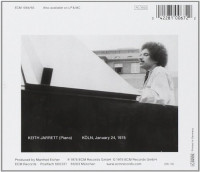|

The Köln Concert
From Wikipedia, the free encyclopedia
The Köln Concert is a concert recording of solo piano improvisations performed by Keith Jarrett at the Opera House in Cologne (German: Köln) on January 24, 1975.[8] The double-vinyl album was released in 1975 by ECM.[9] It became the best-selling solo album in jazz history and the best-selling piano album[10] with sales of more than 3.5 million.[11] According to music critic Tom Hull, the album "cemented his reputation as the top pianist of his generation
Concert and recording
The concert was organized by 17-year-old Vera Brandes, then Germany's youngest concert promoter.[13] At Jarrett's request, Brandes had selected a Bösendorfer 290 Imperial concert grand piano for the performance. However, there was some confusion by the opera house staff and instead they found another Bösendorfer piano backstage – a much smaller baby grand – and, assuming it was the one requested, placed it on the stage. The error was discovered too late for the correct Bösendorfer to be delivered to the venue in time for the evening's concert. The piano they had was intended for rehearsals only and was in poor condition and required several hours of tuning and adjustment to make it playable.[14] The instrument was tinny and thin in the upper registers and weak in the bass register, and the pedals did not work properly. Consequently, Jarrett often used ostinatos and rolling left-hand rhythmic figures during his Köln performance to give the effect of stronger bass notes, and concentrated his playing in the middle portion of the keyboard. ECM Records producer Manfred Eicher later said: "Probably [Jarrett] played it the way he did because it was not a good piano. Because he could not fall in love with the sound of it, he found another way to get the most out of it."[11] While Brandes made an attempt and procured another grand piano up to Jarrett's standards to be delivered as an emergency, the piano tuner who arrived to fix the baby grand warned her that transporting a grand piano without the proper equipment in the middle of a rainstorm would irreparably damage the instrument, forcing Brandes to stick to the small one.[15]
Jarrett arrived at the opera house late in the afternoon and tired after an exhausting long drive from Zürich, Switzerland, where he had performed a few days earlier. He had not slept well in several nights and was in pain from back problems, having to wear a brace as a result. After trying out the substandard piano and learning a replacement instrument was not available, Jarrett nearly refused to play and Brandes had to convince him to perform as the concert was scheduled to begin in just a few hours.[11] Brandes had booked a table at a local Italian restaurant for Jarrett to have dinner before the performance, but a mix-up by the waiting staff caused a delay in the meal being served and he was able to eat only a few mouthfuls before having to leave for the concert.[15] Ultimately, Jarrett decided to play largely because the recording equipment was already set up.[16]
The concert took place at the late hour of 11:30 pm, following an earlier opera performance. The late time was the only one the administration would make available to Brandes for a jazz concert – the first at the Köln Opera House. The show was sold out, filled to capacity at over 1,400 people at a ticket price of 4 DM ($1.72). Despite the obstacles, Jarrett's performance was enthusiastically received by the audience and the recording was acclaimed by critics. It remains his most popular recording and continues to sell well decades after its release.
The performance was recorded by ECM Records engineer Martin Wieland, using a pair of Neumann U 67 vacuum-tube powered condenser microphones and a Telefunken M-5 portable tape machine. The recording is in three parts: lasting about 26 minutes, 34 minutes and 7 minutes respectively. As it was originally programmed for vinyl LP, the second part was split into sections labelled "IIa" and "IIb". The third part, labelled "IIc", was actually the final piece, a separate encore.
A notable aspect of the concert was Jarrett's ability to produce very extensive improvised material over a vamp of one or two chords for prolonged periods of time. For instance, in Part I, he spends almost 12 minutes vamping over the chords Am7 (A minor 7) to G major, sometimes in a slow, rubato feel, and other times in a bluesy, gospel rock feel. For about the last 6 minutes of Part I, he vamps over an A major theme. Roughly the first 8 minutes of Part II A is a vamp over a D major groove with a repeated bass vamp in the left hand, and in Part IIb, Jarrett improvises over an F# minor vamp for about the first 6 minutes.
General
Complete name : Keith Jarrett\The Köln Concert\01 Part I.mp3
Format : MPEG Audio
File size : 23.8 MiB
Duration : 25 min 58 s
Overall bit rate mode : Constant
Overall bit rate : 128 kb/s
Album : The Köln Concert
Album/Performer : Keith Jarrett
Track name : Part I
Track name/Position : 1
Performer : Keith Jarrett
Composer : Keith Jarrett
Genre : Jazz
Recorded date : 1975
Audio
Format : MPEG Audio
Format version : Version 1
Format profile : Layer 3
Format settings : Joint stereo
Duration : 25 min 58 s
Bit rate mode : Constant
Bit rate : 128 kb/s
Channel(s) : 2 channels
Sampling rate : 44.1 kHz
Frame rate : 38.281 FPS (1152 SPF)
Compression mode : Lossy
Stream size : 23.8 MiB (100%)
B)
|
|
udp://opentor.org:2710/announce udp://tracker.torrent.eu.org:451/announce udp://exodus.desync.com:6969/announce udp://tracker.moeking.me:6969/announce udp://tracker.opentrackr.org:1337/announce udp://tracker.tiny-vps.com:6969/announce udp://open.stealth.si:80/announce udp://tracker.theoks.net:6969/announce udp://retracker.lanta-net.ru:2710/announce udp://movies.zsw.ca:6969/announce udp://newtoncity.org:6969/announce |

